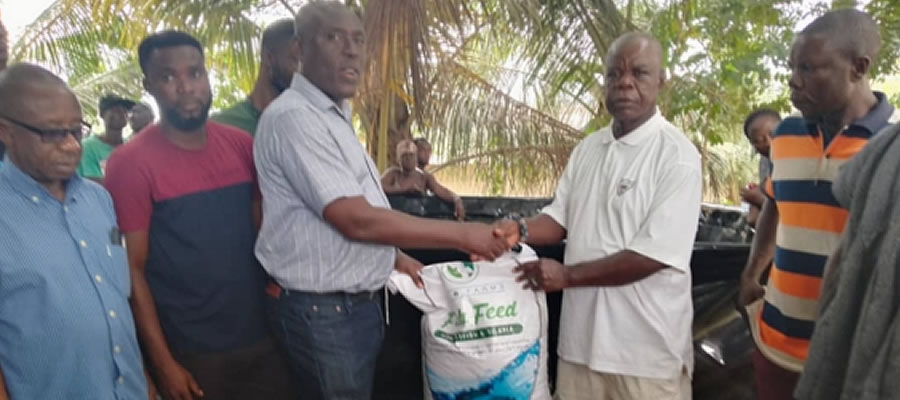

Primary Sector Agriculture
The agricultural sector provides food, fish and meat for the district and constitutes the major economic activity of the people in the Gomoa East District. Total agricultural land is estimated at169.25 sq. Meters. The soil type is loamy, sandy loam and clayey supporting a variety of crops. The vegetation of the district which is made up of semi-deciduous forest and coastal savannah grassland, to a large extent, influences the economic activities of the people that is crop, animal and fish production.
The fishing sector includes marine and fish farming with the former employing about 8,000 men and 3,000 females. There are however, very few though on small scale aqua-culture in areas around Okyereko, Nsuem and Adzentem. The ecology of the district encourages the cultivation of crops such as cassava, maize, sugar cane, pineapple, rice, pawpaw, vegetable, citrus; yam and plantain. This has given rise to cultivation of non traditional crops such the Asian Vegetables, chilly and bird eye pepper and pineapple. The farmers in the district rely heavily on the two rainy seasons for production.
The land tenure arrangements in the district include renting, direct purchase and inheritance of family lands. The main methods of storing agricultural produce are by cribs, kitchen tops and store rooms with no bulk storage facility for food crops. MiDA has established a pack house at Buduatta along Winneba Accra road to help farmers deliver quality fruit and vegetable for the export market.There is no agro input outlet in the district; as a result, farmers depend on the supplies from the adjoining district. The district has three dams. Two of the dams are private owned, which is used to support pineapple and vegetable production for export. Government owned dam located at Okyereko was constructed to constantly supplement water to irrigate the rice project annually.
Generally, farming in the district employs about 12,075 people of which 7,245 (60%) are males and 4,830 (40%) are females respectively. This implies more males are employed in this sector than their female counterparts. The scale of production is mostly on subsistence level with an average farm size of 0.4 hectares. This means that produce from the farms are used to feed immediate family and very little sold to raise income for the family. Females are also known to engage in petty trade including the sale of farm produce as the males supervise the farms.
There are few farms on large scale production with an average size of 25 hectares. These include Kristo Asafo farms (maize), the President’s Special Initiative for Cassava at Adzentem, etc. Milani, Akramang Processing, Chartered Impex, Joro farms, Taqwa farms, Yadana, Aglow farms, among others producing mainly pineapple for export and processed fruit for the local market. There are also cooperative farmers’ organisations such as the Okyereko Rice Cooperative, producing one of the best rice grains for the local market but lacks packaging technique.
Livestock production is low compared with the crop subsector. Production of small ruminants is basically on free range with no slaughter house to assess meat quality. Natural grasses serve as the main source of pastures for both small ruminants and cattle. Major poultry industries are the Aglow farms, Ahmmadiyya farms, Vims and others which produce live birds, poultry meat and eggs for the local consumers.Fishing enterprise can boost of both marine and aquaculture with the former employing the majority of the fisher folks. Aqua culture production is however on the increase due to deficit in fish supply to meet the high demand from the district and other areas.
The district in 2008 to 2009 had seven (7) Agriculture Extension Agents (AEAs) with an agriculture extension officer-farmer ratio of 1:1,725 which is quite high compared to the national figure of 1:1,500 in 2009. This implies that each AEA in the district has an excess of 225 of farmers to attend to, which in total means about 1,575 of famers who form about 13.0% of the total number of farmers would find difficulty in accessing extension services. Consequently, only a few farmers will have the benefit of knowledge on modern farming methods, practices and other technical information to improve and sustain their farming activities, which ultimately will affect both productivity and production levels in the district.
Crop Production
Major crops produced in the district include maize, cassava, plantain, pineapple, yam and pepper. The major farming system practiced in the district is continuous cropping and crop rotation. Statistics from the agricultural sector in the 2008 to 2009 indicates that only plantain and pineapple recorded increase in production whereas pepper, yam, cassava and maize recorded decrease in production. This has been due to a variety of factors including insufficient and unreliable rains, difficulty in accessing credit, high cost of inputs, etc. Number of seed maize growers producing certified seed for food production in the district is 19 (16 males and 3 females). Total acreage under cultivation is estimated at 209 acres as at May, 2010.
There are about 26 Farmer Based Organizations (FBOs) in the district. The FBOs employ 1,305 farmers of which 783(60.6%) and 602 (39.4%) are men and women respectively. These FBOs are engaged in the production food crops including maize and vegetables ( tomatoes, pepper, garden eggs, okra) for the local market while green chillies, marrow, etc. production is mainly targeted for the export markets.
Livestock
Livestock farming in the district is mainly on subsistence level. However, there are about 8 commercial farmers employing about 100 people. These include VIMS farms and MORGAN farms located at Gomoa Manso; CEBAS farms at Ojobi, cattle ranches at Pomadze, Kojo-Oku and Bewadze, Piggery at Bewadze and Nsuaem. This sub-sector has great potentials in transforming the local economy if the farmers could observe good husbandry practices and are also encouraged to use improved breeds to better stock quality.
Fishing
Fishing forms the main economic activity of the coastal communities. It employs about 8000 fishermen and 3000 fishmonger. The main fishing communities are Nyanyano, Dampase and Fetteh. The fishermen normally use canoes with either outboard motors or paddles. All kinds of fish are landed depending on the season. The main catch includes herrings, lobsters, tuna, shrimps, sole and octopus. Catches made during the season from the district is meant for market centres at Accra, Mankessim, Kasoa, Kumasi and Techiman. In the off-season, most of the fishermen migrate elsewhere both within and outside the country for fishing. Unfortunately, these fishing communities have no cold stores to store their catch.
Food Security
Over all enough food crops and livestock products are produced in the district resulting in surpluses of maize and cassava to neighbouring district. Production deficit along the coastal belt are compensated with favourable access to food and movement of food from surplus to deficit areas. However, the poor and vulnerable in the district facing regular food insecurity due to limited production, financial capital and also quality of nutrition remained important problems.
Unfavourable weather conditions could affect food production and distribution in the district leading to high food prices but provision of small irrigation schemes can boost crop production. Farmers are finding it difficult to store their produce during the periods of glut so silos should be put up in the district to store excess farm produce. Government in initiatives on expanded crop production, block farming and subsidies are geared towards an increase in food production levels but access to land is becoming a serious issue.
The District Assembly should therefore facilitate the reservation of land in communities for agricultural activities. Again access to farm transport to facilitate the carting of farm produce to reduce and eliminate the risk of farmers losing the produce to bad roads. This and the practice of traditional farming systems serious affect the income of farmers. The introduction of modernisation of agriculture through the use of improved technologies mechanization and better agronomic practices could enhance farmers’ income.
The Agricultural sector in the district is confronted with a lot of challenges which include;
• Offices and residential accommodation for MOFA staff
Low AEA farmer ratio
Inadequate logistics for MOFA staff
Absence of bulk storage facilities.
Inadequate irrigational facilities for dry season farming
Scepticism on the part of farmers to deal with new technologies.
High cost of agriculture inputs
Inadequate market for agricultural products
On-going programmes and initiatives to improving the agricultural sector of the district include:
Cocoa Mass Spraying
MIDA Programmes especially in the horticultural products
Youth in Agriculture Programmes (Block farming)
Export Marketing and Quality Awareness Project
Farmer Registration
Root and Tuber Improvement and Marketing programme
Clean farm project aiming at collecting unwanted, obsolete pesticides and empty agrochemical containers.
These initiatives are attempts to sustainably tackle the issue of food insecurity and also to reduce the rate of unemployment in the district.
Date Created : 11/17/2017 5:36:38 AM









 facebook
facebook
 twitter
twitter
 Youtube
Youtube
 +233 593 831 280
+233 593 831 280 0800 430 430
0800 430 430 GPS: GE-231-4383
GPS: GE-231-4383 info@ghanadistricts.com
info@ghanadistricts.com Box GP1044, Accra, Ghana
Box GP1044, Accra, Ghana